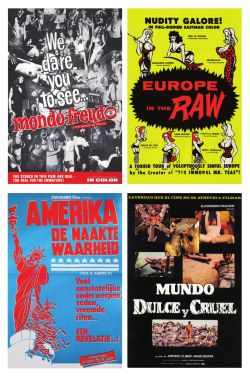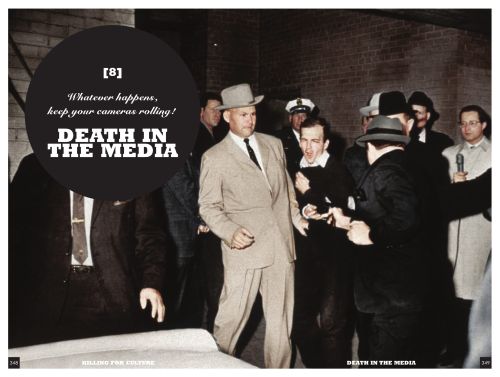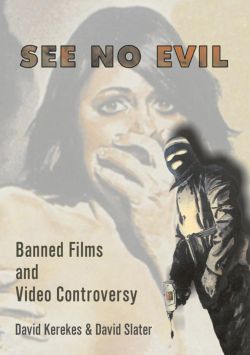
Capturing Death On Film [2017-01-30]Since the very first moving images were shown the idea of death on film(be it simulated or real), has shocked yet fascinated mankind. Killing for Culture is a lengthy, highly detailed, and thorough tome- looking into & discussing the history of death on film- be it snuff, mondo films, televised deaths, internet executions, etc. The book originally appeared back in 1993 as a 285 page publication- late last year a new & updated version of the work was released doubling the page count. I tracked down the books authors David Kerekes & David Slater- for a email discussing the recent publication & their work together in general. M[m]: Tell us a little bit about how you both met each other, and when/ how did you decided to start writing together?
David K: I met Dave through the Dark Side magazine classified ads section. I had a bunch of pre-cert tapes to trade and he got in touch after seeing the ad, being a collector at the time like me. Turns out we haunted pretty much the same places in Manchester, the same bookshops and had the same interests in movies and books. Our paths must have crossed a few times. After that we were in contact regularly. We were writing and editing Headpress together. But I think it was on Killing for Culture that we actively started to collaborate on writing.
David S: We initially made contact through a classified ad in one of the numerous popular magazines dedicated to the VHS trade. We traded tapes through the post until realising it made more sense to meet up. Meeting to swap tapes soon turned into meeting for beers. It was over a few pints that the idea for Headpress and ultimately Killing for Culture came about.
M[m]: When writing together do you have set roles/ chapters you work–on? Or is it a free for all?
David K: For both Killing for Culture and See No Evil we decided on specific chapters that we would each tackle, or certain subject areas. When I wrote my parts I gave them over to Dave and he would add material or elaborate on what was there and make suggestions, change some things round. And vice versa.
David S: A free for all would have been a bit of a disaster. We each choose which films and subjects to cover. With See No Evil we took turns selecting a film from the DPP list so each of us had an equal amount of good and bad films to cover.

M[m]: You’re most recent collaboration comes in the form of Killing for Culture- which is an updated version of your 1993 book about Killing on film & mondo films. What made you decide to do an updated version of the book & how long had you been planning the new edition?
David K: The updated edition of Killing for Culture was in the pipeline for years. It was announced as forthcoming on a number of occasions but failed to materialise for one reason or another. But the 1993 book had fallen out of print and it felt right to update it. Now I feel it’s a good thing that the 2016 revised edition didn’t come out sooner than it did. It would have missed a number of important developments had it been finished and published say ten years ago, or even five years ago.
David S: The advent of the Internet is what decided the need for an update. At one point we considered a totally autonomous book Killing for Culture 2 as there was so much new material. But we felt the original needed a rework so we went with the revision and update. We have been working on it in stops and starts for a very long time. Often world events would mean adding more to the book when we considered it finished. It kind of just continually grew until we forced a cut off point.
M[m]: One of the main developments since the original version of Killing For Culture is the growth of the internet. And of course this has changed the way killing has been captured on film. Of all you investigation for the new version of the book, what was the most shocking footage you found?. And did you draw a line on what you decided to view/ cover in the book?
David K: The Internet is the best way to analyse the difference between this new edition of the book and the previous ones: the earlier editions have no mention of the Internet! Because of the Internet the attitude of death on film and the way we watch it have changed completely. Scenes of death on film were once packaged and recycled in mondo documentary films; thus contextualised to some extent. Beyond this there wasn’t much by way of death images on film and it took a concerted effort for people to see them. Now clips of beheadings float around the Internet – merely something else to watch online. Or not as the case may be. But given that these clips also show up on social media and news feeds, one tends to have to make an effort to avoid them rather than seek them out.
The most shocking footage? Beheadings and Mexican cartel executions are pretty shocking. I personally didn’t watch all the ones out there for the book – what would be the point? The book is big enough as it is!
David S: Compared to the early mondo films which often fabricated the death scenes the stuff released to the Internet is clearly real, horribly so. With the mondos you could work out how the trickery was done and thus defuse the horror. With these you can't. It's difficult to say what the most shocking footage was. Islamic State and the Mexican narcos have taken charge of the atrocity video each coming up with more brutal and inventive ways in which to kill a person. It would be those that were viewed with the most dread. But perhaps the most disturbing were those produced by "lone-wolf" individuals as a leisure activity.

M[m]: A big part of Killing for Culture is the discussion/ proving there is no real evidence of Snuff. Why do you think the belief in the snuff still existence & what do you think is the appeal to people in believing that they could exists?
David K: There is always a fascination for urban legends, and this is what helped maintain the snuff film rumours for so long. Conversely, the use of the term 'snuff film' seems to have diminished somewhat now that we are confronted with so much death on-line. These are not snuff films in the sense of the urban legends -- i.e. they are not films of murder created for an underground market of a few sick individuals with the money to buy such a film -- but rather they are ISIS beheading videos and cartel execution videos created for propaganda purposes and uploaded for the all the world to see. I suppose the supply of these authentic scenes of death has taken the edge off the 'necessity' of having a legend.
David S: The snuff film as we understand it, a film depicting genuine murder produced for the purpose of selling to an elusive clientele, has yet to surface. As such it remains in the urban myth status. There are many anecdotes claiming such films exists but the anecdotes all lack the tangible reels of film or video tapes. This of course doesn't mean they categorically do not exist, for all we know there very well may be some rusting canisters buried in the desert. But all the stories tend to lead to misinterpretations, exaggerations, lies and fabrications. The snuff stories tend to come in waves then recede, often being associated to a controversial topical event such as the Jimmy Savile scandal. It's just an add-on to augment the frisson and mystery of an already shocking occurrence. It's appeal will never die and the notion of the snuff movie recently resurfaced in the BBC series Inside No.9 in an episode entitled The Devil of Christmas.
M[m]: In new edition of the Killing For Culture you briefly discuss shock footage relating to more experimental & experimental forms of music. Are either of you personally fans of more experimental sonic fare? And if so what?
David K: Experimental forms of music I encounter quite a lot, and some of it is experimental or abstract. But I don’t go out of my way to listen to noise and power electronics, which is usually associated with extreme images, and what some people think I might be into. I get to hear those forms of music because of people I know who are into it, and I’ve been to some gigs (and Headpress published Fight Your Own War: Power Electronics and Noise Culture), but it’s not what I chose to listen to. I’m usually listening to Tomorrow Never Knows on a loop.

M[m]: Tell us a little bit about you how originally got fascinated in mondo/ Shockumentary films? And what trigged you to write the first edition of the book?
David K: Mondo films are to cinema what Altamont is to popular music. They are odd on every level and sometimes revolting. Mondo films have always been frowned upon, even as a box office draw in the sixties and seventies. But given that some of the earliest examples are over fifty years old, they look even more like strange nuggets that don’t belong. It was inevitable that Dave and I would be fascinated.
David S: It was while trading banned and bootleg video titles that we first came across the mondo genre. It was something new and something very startling. We couldn't help but take an interest not just because of the alarming visuals but that they often presented made-up nonsense as fact. It was" post-truth" and "fake news" long before those notions came into popular usage.
M[m]: Please select five of your favourite Mondo films & explain why?
David K: I don’t know if choosing five mondo films would say very much. There are some good ones, and influential ones, but I don’t have enough of an emotional attachment to call any favourite. It’s difficult to feel that sort of attachment to a mondo film! Killing of America is good, and I wouldn’t mind seeing the remastered version on Blu-ray that’s recently come out. Mondo Cane is ground-breaking and well-crafted but I wouldn’t care if I never saw it again, as I wouldn’t Faces of Death or Africa Addio, or This Violent World.
David S: I couldn't say I had a favourite. After viewing a few they tended to blend into a single entity. They followed the same formula. As time went on they evolved into much cheaper productions and became a series of edited together clips void of any narrative. That's when they became unwatchable and the genre fizzled out. I tried to watch Faces of Death on Bluray but spent most of its running time browsing on my tab. They were a thing of their time.
M[m]: The other book you have collaborated was See No Evil: Banned Films and Video Controversy- which mainly focused in on the video nasties/ ddp list of films 1980’s Britain. What first got you interested in this subject, when did the idea come about to do the book, and as it’s now out of print do you have any plans to re-issue it?
David K: Dave and myself were very much a part of the whole ‘video nasties’ culture, in that we were collecting movies on videocassette -- along with many hundreds of other people across Britain -- using the DPP ‘banned’ list as a kind of shopping list. The moral panic stirred up by the media, and its fallout, touched a lot of people. It was obvious to us to write a book about it.
David S: As it does, it was the banning of the films that drew our attention to them. We spent a lot of time and met a lot of interesting people building personal collections of the films on the DPP list. It was great fun. The media-stoked moral panic was also fascinating as a cultural happening in the way it polarised people's attitudes towards films.

M[m]: Do you have any plans for any future book collaborations together?
David K: There’s an updated See No Evil(our book about the video nasty phenomena) in the pipeline.
M[m]: Can you give us any info about what to expect in the updated version of See No Evil, & when you hope to release it?
David K:The updated See No Evil contains, among other things, interviews with the BBFC (which the previous edition didn't) on the matter of the "video nasties" era. Hopefully it will see print at the end of this year.
M[m]: Clearly you are both huge fans of shocking cinema. Are there any films in the last five years that have had a really impact on you from within the horror/ experimental genres?
David K: I saw Passengers yesterday. I enjoyed that. And I saw Scorsese’s Silence the day before that, which I didn’t enjoy. There were experimental and horror aspects to both of them; Hollywood movies that are outside the box to some degree. Impact? If I come away from any film these days that has one moment or scene that makes me go “wow” I am happy, my expectations are so low.
David S:I really can't think of anything that has made an impression on me in recent time. I've become somewhat regressive and nostalgic and would be happier rewatching a Hammer or Universal horror film that a contemporary one. I find today's offerings persistently disappointing. The ones that comes to mind that struck a positive chord are The Wailing and the first half of It Follows.
M[m]: what’s lined up next for Headpress over the next few months?
David K: A book on television movies, an update of a book on Nigel Kneale that has been out of print for a while, an update of Sweet & Savage, our book on mondo movies… Others. The best way to find out is to join the Headpress mailing list, which you can do on our website. There will be books we slip out that aren’t included in the above, and in editions not available elsewhere.
M[m]: Talking about Headpress in general- do you have any favourite titles? And if so why do they stand out to you
David K: My favourite Headpress title is The Complete Illustrated History of the Skywald Horror-Moon, by "Archaic" Al Hewetson. It was such a joy to be in touch with Al, the editor of the 1970s Skywald horror comics, and many of the people involved in that scene. I grew up on the comics Psycho, Nightmare and Scream.
www.headpress.com
www.worldheadpress.com
Thanks to Mr Kerekes & Slater for their time & effort with the interview. Killing For Culture is now available for order direct from Headpress- so head here to pick-up a copy direct. Roger Batty
| 
